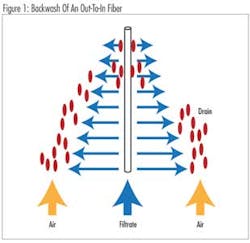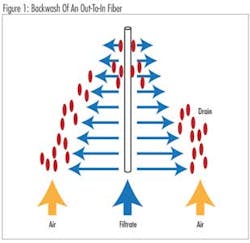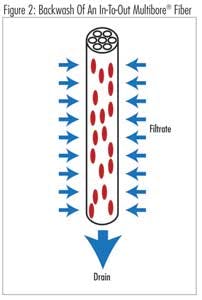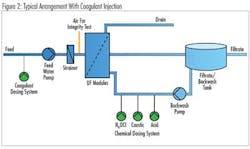New Membrane System Offers "No-Break" Fibers
A new membrane treatment system that will be on display at WEFTEC features a low-pressure polymeric membrane with fibers specially constructed to never break. Not only do these "no-break" fibers save the end user the cost of repairing fibers, but they also have higher permeability, more resistance to fouling, and less power/chemical requirements than other MF and UF membranes, according to the manufacturer.
The Aqua UltraFiltration system, offered by Aqua-Aerobic Systems, uses special hollow-fiber membranes manufactured by inge GmbH, a division of BASF, at their production facility in Greifenberg, Germany. Unlike other hollow-fiber membranes, where each fiber is a thin strand with a single bore running through it, each inge fiber has seven bores running through it.
In addition, this patented Multibore® fiber is made from a single material. The result is analogous to the strength of a rope made from several cords put together: other membrane manufacturers use a single membrane fiber, while inge has melded seven fibers together to form a stronger, multibore fiber.
Most other membrane fibers are manufactured using a thermally induced phase separation (TIPS) process, while the Aqua UF membrane is made with a solvent-induced phase separation (SIPS) process. While the TIPS process creates a stronger and thicker membrane, the SIPS process produces a membrane with higher permeability and lower transmembrane pressure (TMP), which results in a system with fewer membranes and lower pumping costs to treat the same flow. The SIPS process weakens the typical single-bore fiber, but doesn't diminish the strength created by the multibore construction of the inge fibers.
The membranes used in the Aqua system are made of polyethersulphone (PES). Most MF and UF membranes are made of polyvinylidene fluoride (PVDF) because it is more flexible (less brittle) than PES and is more resistant to chlorine and other oxidants. However, the difference in flexibility between the two materials has absolutely no bearing on the strength of inge's multibore fiber. Because PES is cleaned with caustic - and not chlorine, as PVDF is – the difference in chlorine resistance is no longer significant.
Since material strength and chorine resistance are not issues with the multibore fibers, PES is used because it gives several advantages over PVDF that result in lower O&M costs:
- PES is more hydrophilic than PVDF, so solids have less tendency to "stick" to the membrane surface. This means that less backwash water and cleaning chemicals are needed to remove the solids.
- Pores in PES can be made smaller and more uniform than in PVDF. As a result, less pressure is required to get the same flow through the same membrane area. Also, more viruses are rejected; the inge membrane is rated for 4 log virus removal.
- PES can be cleaned at higher pHs than PVDF. Since caustic is better at dissolving organics than chlorine, less chemical is needed.
Better Backwash Efficiency
During filtration on most MF and UF membranes, the feed water flows from the outside of each fiber, through the fiber material, to the bore inside the fiber. In contrast, filtration on the Aqua UltraFiltration system is from inside each multibore fiber to the outside of the fiber. To make sure the solids are filtered out evenly over the full length of the fiber, flow to the fiber is alternated between the top and the bottom of the membrane module.
The advantage of the in-to-out flow path really occurs during the periodic backwash cycles, where the flow is reversed. On standard out-to-in membranes, there is a drop in pressure as the backwash water flows up through the inside of the fibers such that the flow through the bottom of the fiber is more than through the top of the. In addition, compressed air is needed to remove the solids that collect on the outside of the fibers at the bottom of the module.
On the in-to-out membranes used by the Aqua system, there is no pressure difference between the backwash water entering the top of the fibers and that entering the bottom of the fibers, so the backwash flow is even. Less backwash water is needed to achieve the same level of solids removal. Also, air is not required because there is nowhere for the solids to collect; therefore, the system doesn't have blowers to maintain and uses significantly less power.
Lower Plugging Tendency
While the commonly-held belief is that in-to-out membranes have a higher tendency to plug with solids, the opposite is actually true of the Aqua UF membrane. There are several reasons for this:
- The diameter of each fiber bore is larger than other in-to-out membranes; 0.9 mm bores are used for waters with average influent turbidities up to 50 NTU, and 1.5 mm bores are used for waters with average influent turbidities up to 200 NTU.
- The hydrophilic nature of the membrane minimizes solids accumulation on the membrane surface.
- The in-to-out flow path means there are no solids to collect on the outside of the fibers; this is the main reason for plugging of out-to-in membranes.
- Coagulant is often injected into the influent, which lowers the tendency of the solids to adhere to the membrane.
When a small amount of coagulant is added to the influent, fewer membranes are required to obtain the same system flow and less backwash water and chemicals are needed to clean the membranes. This offsets the cost of the coagulant such that there is actually a net savings in operating costs.



